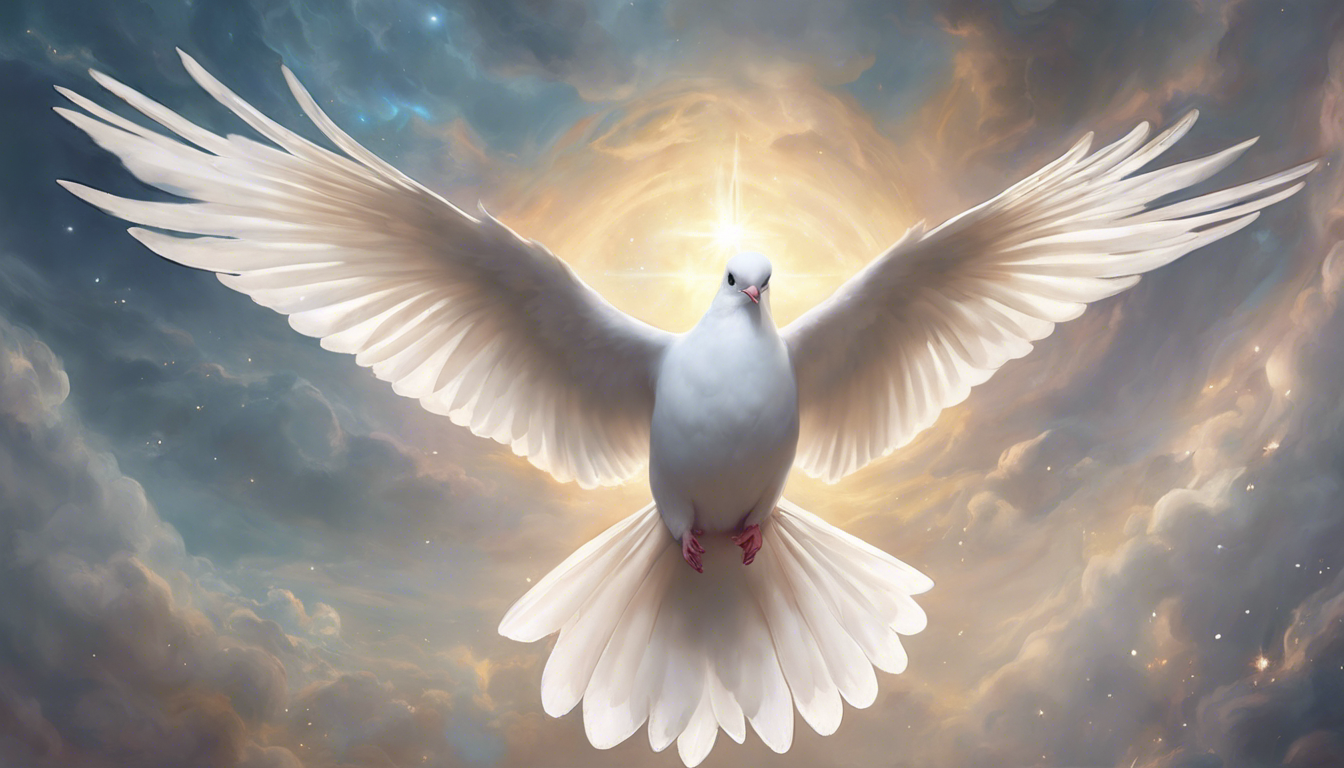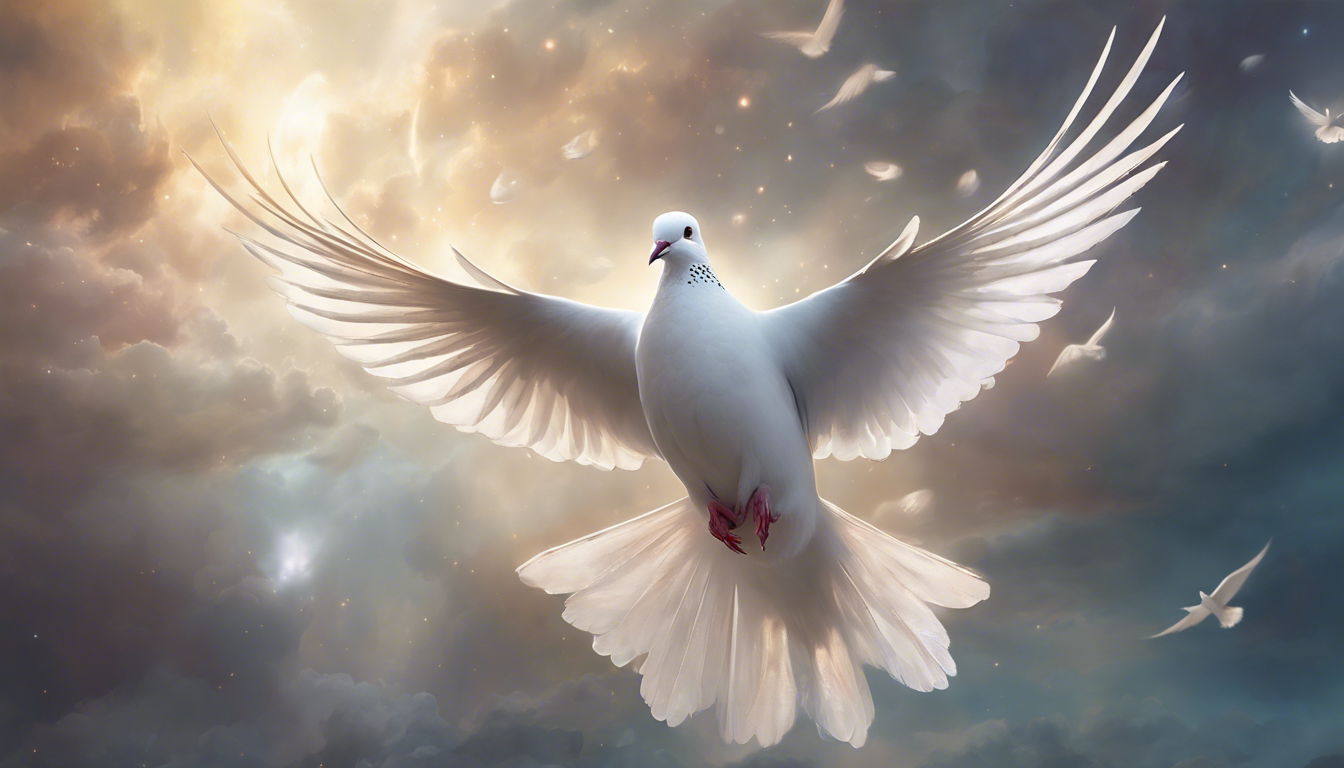The symbolism of doves in cultural history
Throughout cultural history, doves have been revered as symbols of peace, purity, and divine connections. From ancient civilizations to modern society, these graceful birds have held a significant place in our collective consciousness. Let’s explore the rich symbolism of doves and how they have influenced various cultures.
Ancient Egypt: Messengers of the Gods
In ancient Egypt, doves were considered sacred animals associated with the goddess Isis. They were believed to be divine messengers, carrying prayers and blessings between humans and the gods. Doves were often depicted with wings outstretched, symbolizing their role as intermediaries between heaven and earth. Their presence in religious ceremonies and artworks highlighted their esteemed status in the ancient Egyptian society.
Greek Mythology: Symbols of Love and Fidelity
In Greek mythology, doves were associated with Aphrodite, the goddess of love and beauty. These birds were considered symbols of love, fidelity, and devotion. The mythological story of Aphrodite being accompanied by doves further emphasized their connection to romance and peaceful relationships. The image of two doves together became a popular motif in ancient Greek art, representing the eternal bond of love.
Christianity: The Holy Spirit
In Christianity, doves are closely linked to the Holy Spirit. The image of a dove descending from heaven is a powerful symbol of divine presence and guidance. This symbolism originated from the biblical account of the baptism of Jesus, where the Holy Spirit appeared in the form of a dove. Since then, doves have been associated with peace, purity, and spiritual enlightenment within Christian traditions.
Japanese Culture: Symbols of Peace and Prosperity
In Japanese culture, doves, referred to as “hato,” are considered symbols of peace, harmony, and prosperity. These birds are often depicted in traditional artworks, such as paintings and ceramics, as well as used in traditional ceremonies. In the ancient Japanese art of origami, folding paper doves symbolizes wishes for peace and good fortune. The symbolism of doves in Japanese culture reflects the desire for a peaceful and prosperous society.
The symbolism of doves in cultural history is multifaceted, representing various concepts such as peace, divine connection, love, fidelity, and prosperity. These graceful birds have left an indelible mark on human civilization, inspiring artists, poets, and spiritual seekers for centuries. Whether in ancient Egypt, Greek mythology, Christianity, or Japanese culture, doves continue to be timeless symbols of beauty, purity, and hope in our world.
Religious connotations and biblical references

In the realm of literature, art, and even everyday language, religious connotations and biblical references are commonly used to convey deeper meanings and evoke a sense of spirituality. These references are not only found in religious texts themselves, but also in works of fiction, poetry, and popular culture. In this article, we will explore the significance of religious connotations and biblical references and understand their power to inspire, illuminate, and provoke thought.
The Power of Religious Connotations
Religious connotations carry with them a rich symbolism and cultural significance. By utilizing these references, writers and artists can tap into a collective knowledge and shared understanding of religious ideas and values. For example, mentioning the “Garden of Eden” immediately evokes images of paradise lost, temptation, and the fall of humanity. Similarly, the concept of “divine intervention” suggests a higher power’s intervention in human affairs.
These connotations serve to add depth and complexity to the meaning of a literary work or piece of art. They can evoke a range of emotions, from awe and reverence to fear and guilt, depending on the context in which they are used. In this way, religious connotations provide a powerful tool for storytellers to connect with their audience and provoke a thoughtful response.
The Influence of Biblical References
The Bible, as one of the most widely read and studied books, holds a significant place in both religious and cultural history. Its stories, characters, and teachings have shaped the way we think, and its influence can be seen in various forms of artistic expression.
Biblical references can be used to enhance the meaning of a literary work or to explore universal themes and archetypes. For example, the story of Adam and Eve can be interpreted as a symbol of human nature and our innate capacity for both good and evil. The parables of Jesus provide moral lessons and insights into the human condition that resonate with people of different faiths and backgrounds.
Moreover, biblical references can also be used as a way to connect with a specific audience that shares a religious background or familiarity with biblical stories. They can create a sense of belonging and identification, as well as deepen the emotional impact of the work.
Examples in Literature and Pop Culture
Religious connotations and biblical references can be found in numerous works of literature and popular culture. Some notable examples include:
| Literature | Pop Culture |
| John Milton’s “Paradise Lost” | George Lucas’ “Star Wars” series |
| William Shakespeare’s “Hamlet” | Alan Moore’s “Watchmen” graphic novel |
| Herman Melville’s “Moby-Dick” | U2’s song “I Still Haven’t Found What I’m Looking For” |
In each of these examples, religious connotations and biblical references serve to deepen the meaning of the work and engage the audience on a spiritual level.
In Conclusion
Religious connotations and biblical references have a profound impact on literature, art, and popular culture. They add layers of meaning, evoke emotions, and connect with readers and viewers on a spiritual level. Whether used to explore universal themes, convey moral lessons, or create a sense of identification, these references have the power to inspire, enlighten, and provoke thought.
Dove as a universal symbol of peace and love

The Dove: A Timeless Symbol of Peace
Throughout history, the dove has been revered as a universal symbol of peace. Its graceful flight and pure white feathers have captivated the imaginations of people from different cultures and backgrounds. The dove’s association with peace dates back to ancient times, making it a powerful and timeless symbol.
Symbolic Meanings of the Dove
The dove’s symbolism goes beyond its physical appearance. It is often associated with calmness, harmony, and tranquility. The image of a dove with an olive branch in its beak signifies peace and reconciliation, a visual representation of hope and a better future. The dove’s gentle nature further reinforces its association with peace and love.
The Dove as a Spiritual Symbol
In many spiritual traditions, the dove holds great significance. In Christianity, the dove is linked to the Holy Spirit and represents purity, love, and faith. The story of Noah’s Ark in the Bible tells how a dove carrying an olive branch brought a message of peace and hope to humanity after the Great Flood.
In Hinduism, the dove is associated with the goddess Saraswati, the embodiment of knowledge, wisdom, and harmony. The divine dove symbolizes the pursuit of inner peace and spiritual growth.
Dove Symbolism in Different Cultures
The dove’s symbolism extends beyond religious or spiritual contexts. In many cultures around the world, the dove represents love, unity, and understanding. In ancient Greece, the dove was associated with Aphrodite, the goddess of love and beauty.
In Native American culture, the dove is linked to peace and harmony among tribes. It is seen as a messenger sent by the Great Spirit to bring a message of unity and cooperation.
The Dove in Modern Times
Even in modern society, the dove continues to be a powerful symbol of peace and love. It is often used in art, literature, and popular culture to convey messages of hope, solidarity, and reconciliation.
One notable example of the dove’s significance is the Peace Dove logo used by the nonprofit organization, Amnesty International. The logo represents their mission to promote peace and protect human rights worldwide.
The dove’s enduring symbolism as a universal symbol of peace and love speaks to the deep-rooted desire for harmony and understanding among humanity. Its gentle nature, association with spiritual traditions, and representation in various cultures around the world make the dove a powerful emblem of hope and unity.
As we strive for a more peaceful world, let us embrace the symbolism of the dove and work towards fostering peace and love in our own lives and communities.
Dove as a symbol of hope, freedom, and harmony

The Symbolic Meaning of the Dove
The dove has been a powerful symbol throughout history, representing various notions such as peace, love, purity, and innocence. In many cultures and religions, the dove holds a special significance, being seen as a messenger of hope, freedom, and harmony.
Hope and Freedom
The dove is often associated with hope and freedom due to its ability to soar high in the sky. Its graceful flight and gentle nature create a sense of tranquility and liberation. The dove’s wings are seen as a symbol of freedom, representing the freedom of the spirit and the pursuit of dreams.
In ancient Greek mythology, the dove was often associated with the goddess Aphrodite, the goddess of love and beauty. Doves were believed to be her messengers and symbols of her divine presence. In this context, the dove represents hope for love and harmony in relationships.
Harmony and Unity
The dove is also seen as a symbol of harmony and unity. In Christian symbolism, the dove is often associated with the Holy Spirit, representing peace and unity among believers. The image of the dove carrying an olive branch is a powerful representation of reconciliation and harmony.
In Native American cultures, the dove is revered as a symbol of peace and harmony among tribes. It is believed that the dove brings blessings and promotes cooperation and understanding among individuals and communities.
The Dove as a Spiritual Guide
The dove’s symbolism extends beyond its representation of hope, freedom, and harmony. Many people see the dove as a spiritual guide, offering wisdom and guidance on their spiritual journey. The gentle and peaceful nature of the dove serves as a reminder to live in harmony with oneself and others.
In conclusion, the dove is a powerful symbol of hope, freedom, and harmony. Its graceful presence and gentle nature inspire feelings of tranquility and liberation. Whether as a representation of love, unity, or spiritual guidance, the dove holds a special place in our hearts, reminding us of the beauty and possibilities that exist in the world.


Article written by Dera
Greetings, I am Dera, a 35-year-old individual with a deep passion for spirituality. Through my website, I aim to share my insights and knowledge to help others on their spiritual journey. Join me on the path to inner peace and enlightenment.